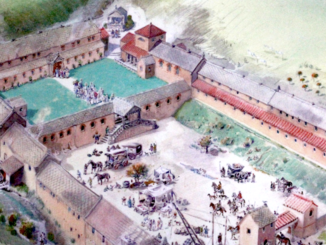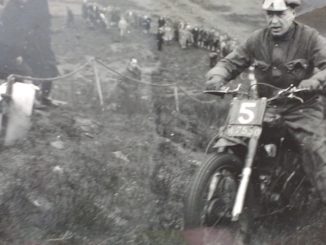
© Google Street View 2023, Google
Last time we strolled through Geneva in the 1980s looking at some of my own old photos. Puffins will be relieved to hear that this week we’re back in the 1950s and travelling in my grandparents’ Ford Prefect clockwise around lake Geneva in the direction of Montreux.
Our first port of call is Nyon, 15 miles north east of Geneva city centre. As can be seen from the aerial photo below, taken just before our family visit, Nyon lies next to Lake Geneva with a fortified medieval town to the west that spread eastwards and northwards when the railway and the motorway arrived. The railway is the Geneva to Lausanne line whose origin stretches back to 1855. About the middle of the photo is a field with a big ‘X’ across it worn by the super-efficient Swiss as they take the shortest possible route between either end of Rue des Marchandises (to the right) and Avenue Viollier (to the left). In this case, the X also marks the spot where our family photos of Nyon were taken.

Nyon,
Werner Friedli – Licence CC BY-SA 4.0
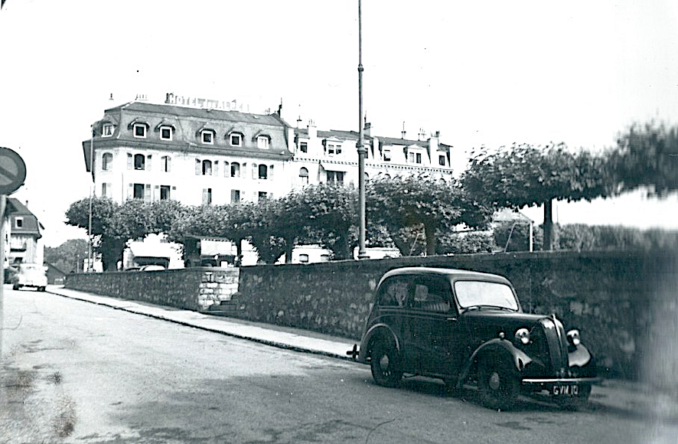
© Always Worth Saying 2023, Going Postal
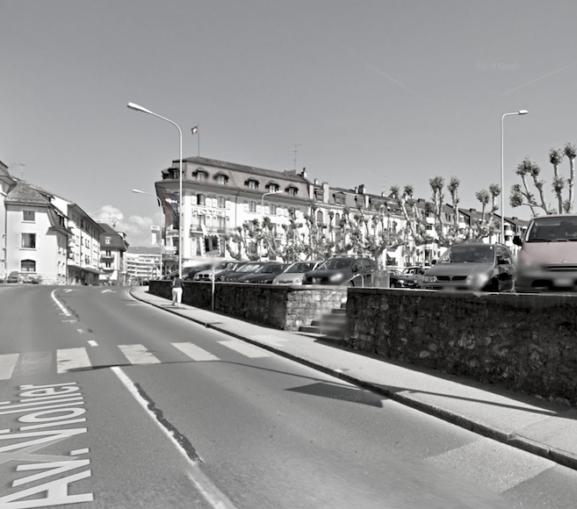
© Google Street View 2023, Google
The hotel is still there and still called the Hotel des Alpes. Bed and breakfast for one in a small and plainly furnished room with a lakeside view touches £300 a night even in February. As well as a view of the lake, the guest is also paying for the view of a 400-space car park which has replaced the sports field visible in the two photographs taken in the 1950s.
© Always Worth Saying 2023, Going Postal
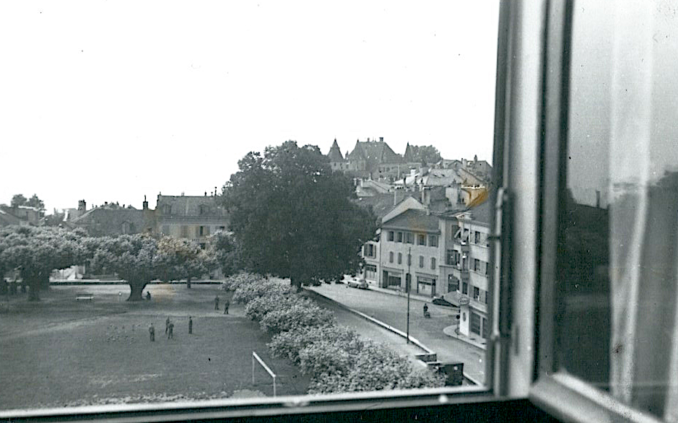
© Always Worth Saying 2023, Going Postal
To the far left, the boxy oblong building is the Salle Communale de Perdtemps, or performance hall, which survives to this day and is used for the same function. To the right, on the skyline, we can see the towers and pitched roofs of Nyon’s restored 13th-century chateau-style castle. Below that, on the street corner and visible with the aid of a magnifying glass, is an Esso sign. As a reminder that everything changes as it stays the same the corner is still a garage, albeit signposted as Garage Central Pierson SA Electricite Sur Automobiles. The big display windows remain in place. Domestic garage-type doors remain on the curved street corner.
On closer inspection, the figures on the football pitch don’t appear to be randomly spaced. Rather to be in groups of 3,4 or 5 with one man standing apart as if something is being explained. Very strange. Is the figure in the bottom right of Picture 5, leaning on a rifle? I wonder if these are Swiss soldiers, or rather Swiss conscripts, under instruction? We’re all familiar with the idea that Switzerland is a neutral country but at times we must pinch ourselves as a reminder that they’re not pacifists. Like Sweden and Finland and near-neighbour Austria, the Helvetic state has to be well-armed and well-organised in order to protect its neutrality.
Although the football pitch between the performance place and hotel hasn’t survived there are plenty more Wendyball safe spaces nearby. Just south of the town centre resides the headquarters of UEFA, the Union of European Football Associations, which is the governing body of football in Europe
Right on the lakeside with pitches on the other side of the Route de Geneva road, UEFA was based in Paris until 1959, moved to Berne until 1995 and then moved to Nyon with the opening of the House of European Football. In 2010 new offices were inaugurated. Named La Clairiere they are housed in a circular four-level building. If you’d like to have a look around, you can via this pdf.
Considering Wendyball is supposed to be the people’s game, it must be said UEFA appears to be administered by rich people who do rather well for themselves. A third building, on what has now become a UEFA campus, is called the Bois Bougy and was opened in March 2012. UEFA also control the nearby Colovray Sports Centre which includes a stadium, football pitch and track and field facilities. This is the home to the Local XI, FC Stade Nyonnais who compete in the third tier of the Swiss football league.
***
Besides Wendyball excesses, Nyon occasionally hits the headlines for other reasons. In November 1924 the Dundee Currier covered the case of a disputed will. A Mr Theodore Schultze made claim that all other interested parties were deceased, or had taken their share peviously, and that he was entitled to a trust dispositioned by a certain Mr Robert Miln, a well-known Arbroath merchant. The trust found its way to Mr Shultze via his mother Nellie, a sister of Mr Milne, who married a Gustave Schultze of St Petersburg who was at one time Consul of Sardinie and Riga. As often with marriages, one wonders how the happy couple ever managed to meet.
Suffice it to say, Gustave was the boring member of the family. Brother Hermann had been an admiral in the Russian navy and had retired/escaped to Nyon where Gustave and Nellie also resided. Interesting nephew Alexander was born in Nyon but educated in St Peterburg and became a Russian army cadet. It was said in court he was shot in the back by the Soviets while trying to cross the frontier out of Russia. It was the demise of Alexander which led Mr Theodore to claim the money. However, as with many a family srcamally over filthy lucre, the case was far from clear cut with the Dundee Currier being forced to conclude, “This tale, however, has not been verified.”
***
In the modern day, above the town lies the E25 highway which runs to Lausanne where it joins with the E23. At Nyon’s turnoff, we find an industrial estate. Not quite the home to B&M Stores and Pets-R-Us, there sits the workshops of Aston Martin of Geneva and the headquarters of the Hublot luxury watch company.
If you assume there’s more money in Aston Martins than in watches, then think again. It’s a closer call than you might expect. A Hublot Tourbillion Automatic Yellow Neon Saxem 44mm (where do they get these names from?) touches the scales at a time warping £182,000. Bit of a complicated thing; see through and containing bigly mechanisms, I’m not quite sure how to tell the time with it.
As well as a highway, a mainline railway line and a lakefront, Nyon lays further claim to be the best place ever by having its own branch line. A single track non-electrified spur attaches the Geneva to Lausanne line to various warehouses, silos and a timber yard.
As we leave Nyon, we will use the old road which my grandparents will have followed and en route, a few miles to the west, we reach an array of aerials.
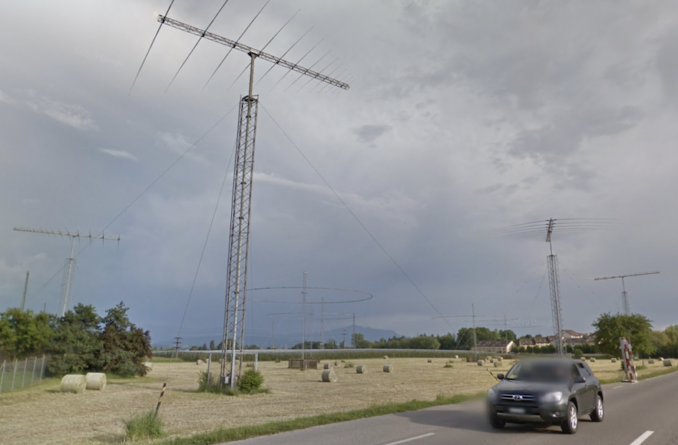
© Google Street View 2023, Google
A building nearby is marked as the ORPC for the Nyon district. ORPC means L’Organisation Régionale de Protection Civile which in English translates as the Regional Civil Protection Organisation. We must assume all these aerials to be their communications equipment. Across Switzerland there are twenty-six cantonal civil protection divisions whose purpose, according to wiki, is:
“To assist the population in the event of harmful events or disasters. It is one of the five pillars of population protection, alongside firefighters, police, technical services and health services (ambulances, hospitals, etc.).”
Previously civil protection was concerned with possible invasion or the effects of nuclear war in nearby countries. These days their responsibilities range from managing traffic during marathons, to the effects of bad weather, to helping with the security at G8 meetings. Many of the staff are volunteers not fit for military conscription but fit for civil protection duties.
En route to rendezvous with our next family photographs at Morges, we shall take a detour inland to a place called Begnins. This is the hillside home to Puffin’s favourite Phil Collins. Perhaps not surprisingly his mansion isn’t on Street View and the view from the nearest public road is spoiled by, not so much the front garden, as the front vineyard. You can have a look at Phil’s pad from the air here.
Before we once more beat Le Collins with a big stick, let us recall a May 2008 Rolling Stone magazine article which announced a forthcoming Phil album had been delayed as he’d been sidetracked making a model railway with his sons in the basement of his Swiss villa.
Phil’s not the only media God to have a model railway. Besides many of your favourites on Going Postal, the long list includes Rod Stewart, Roger Daltrey, Bruce Springsteen, Eric Clapton and Ringo Starr. Not to mention the little black chap of Different Strokes (extra points for wearing the uniform), Tom Hanks, Walt Disney, Frank Sinatra, Neil Young, Pete Waterman, Mrs Eddie Izzard (not of this parish), Jeremy Corbyn, Jules Holland and Herman Goering.
Although cagey about his model rail efforts, Phil has been more upfront about his giant model of the Alamo which is pictured here, albeit in the shadows of a paywall, and which he subsequently generously donated to the State of Texas. Is the Genesis frontman a Puffin after all? I think he might be.
If we carry on up the hillside from Phil’s villa, we come to a country woodland walk that includes ‘the toblerones’. The familiar Swiss chocolate’s name derives from its inventor Theodor Tobler and a ‘torrone’ type of Italian nougat. The toblerones we encounter in the woods are triangular concrete tank traps named after the chocolate. Leftovers from the last war, the plan was to hold the high ground and harry the Germans from there if Switzerland’s neutrality was ended by a Nazi invasion.
As we continue to Morges, just before we enter the township we cross another branch line, this one electrified and winding its way to Briere. There sits a large military base and the home of the CIA. Before you get too excited, that’s the Swiss Army’s Centre d’Instruction de l’Artillerie. Morges is home to parts of the Swiss 1st Mechanised Brigade which consists of reconnaissance, Panzer, mechanised and sapper battalions as well as the artillery group. The Swiss Panzer battalions are made up of German Leopard main battle tanks, in the news at the moment due to the war in the Ukraine.
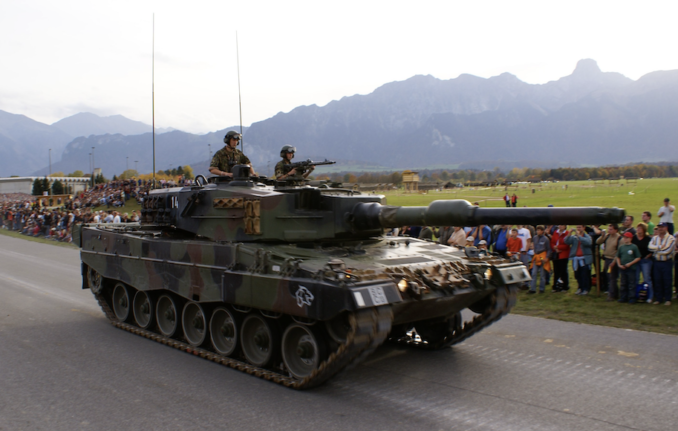
Schweizer Armee. Pz 87 Leo. Kampfpanzer Leopard 2,
Sandstein – Public domain
The Swiss have their own version. If you can make a £200,000 watch, you can make a tank. Currently denoted as the Pz87 Leopard 2, Pz stands for Panzer and 87 was the year of the first delivery to the Swiss Army. Originally the Swiss purchased 134 Leopards, 35 of which were imported from Germany with the rest built under licence by Zurich-based Contraves. Subsequently merged with Oerlikon, another Swiss arms manufacturer, Contraves are now known as Rheinmetall. The part of Rheinmetall’s ‘Weapons and Ammunition’ promotional video advertising 130mm artillery rounds (at 00:24) looks as though it was made on the ranges slightly to the west of the Briere camp. Neutral, not pacifist.
Meanwhile down in Morges and back in the 1950s, perhaps not surprisingly, the military theme continues with soldiers pictured marching along the lakefront past a building clearly marked as the Hotel de Mont-Blanc. This still stands on the town’s Quai de Mont-Blanc.
The hedged fence on the left remains as does the street cafe visible as one parasol. However, the hotel itself has either been completely rebuilt or has had an extra story plonked on top of it.
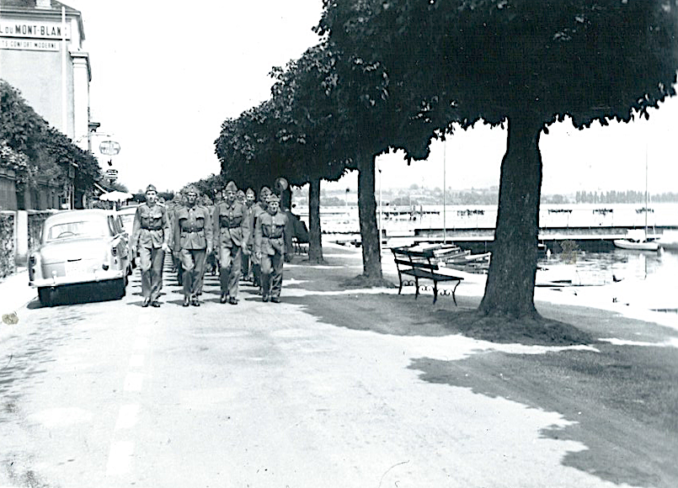
© Always Worth Saying 2023, Going Postal
To the right, a marina remains but beyond, along the lake shore, the promenade has been extended outwards (more obvious in the album photo than the reproduction above). There are now gardens past the avenue of trees. These have obliterated the steps where, nearly seven decades ago, my grandmother is seen surrounded by swans, pleasantly relaxed in an eternally peaceful, technologically advanced and well-defended Switzerland.
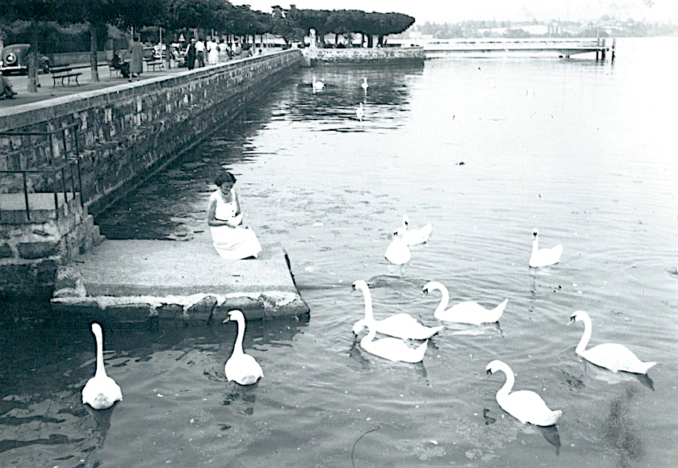
© Always Worth Saying 2023, Going Postal
© Always Worth Saying 2023

